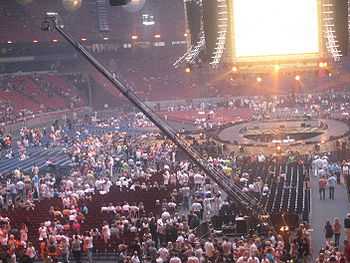Crane shot


In filmmaking and video production, a crane shot is a shot taken by a camera on a crane or jib. The most obvious uses are to view the actors from above or to move up and away from them, a common way of ending a movie. Camera cranes go back to the dawn of movie-making, and were frequently used in silent films to enhance the epic nature of large sets and massive crowds.
The major supplier of cranes in Hollywood throughout the 1940s, 1950s, and 1960s was the Chapman Company (later Chapman-Leonard of North Hollywood), supplanted by dozens of similar manufacturers around the world. The typical design provided seats for both the director and the camera operator, and sometimes a third seat for the cinematographer as well. Large weights on the back of the crane provided a perfect balance to compensate for the weight of the people riding the crane. The weights had to be adjusted carefully to avoid the possibility of accidents. During the 1960s, the tallest Hollywood crane was the Chapman Titan crane, a massive design over 20' high that won an Academy Scientific & Engineering award.[1] Most cranes like this were manually operated, requiring an experienced boom operator who knew how to raise, lower, and "crab" the camera alongside actors while the crane platform rolled on separate tracks. The crane operator and camera operator had to precisely coordinate their moves so that focus, pan, and camera position all started and stopped at the same time, requiring great skill and rehearsal.
Some filmmakers like to have the camera on a boom arm just to make it easier to move around between ordinary set-ups. Most cranes accommodate both the camera and an operator, but some can be operated by remote control. They are usually, but not always, found in what are supposed to be emotional or suspenseful scenes. One example of this technique is the shots taken by remote cranes in the car-chase sequence of To Live and Die in L.A..
During the last few years, camera cranes have been miniaturized and costs have dropped so dramatically that most aspiring film makers have access to these tools. What was once a "Hollywood" effect is now available for under $400.
Types
Famous examples

- The Western High Noon had a famous crane shot. The shot backs up and raises, in order to see Marshal Will Kane totally alone and isolated on the street.
- The 1980 comedy-drama film The Stunt Man featured a crane throughout the production of the fictitious film-within-a-film, directed by eccentric director Peter O'Toole.
- The television comedy Second City Television (SCTV) uses the concept of the crane shot as comedic material. After using a crane shot in one of the first NBC-produced episodes, the network complained about the exorbitant cost of renting the crane. SCTV writers responded by making the "crane shot" a ubiquitous symbol of production excess while also lampooning network executives who care nothing about artistic vision and everything for the bottom line. At the end of the second season, an inebriated Johnny LaRue is given his very own crane by Santa Claus, implying he would be able to have a crane shot whenever he wanted it.
- Jean-Luc Godard, in his film Sympathy for the Devil, used a crane for almost every shot in the movie, giving each scene a 360 degree tour of the tableau Godard presented to the viewer. In the final scene he even shows, on camera, the crane he was able to rent with his budget by including it in the scene somewhat. This was one of his traits as a filmmaker - showing off his budget - as he did with Brigitte Bardot in Le Mepris (Contempt).
- Director Dennis Dugan frequently uses top-to-bottom crane shots in his comedy films.
- Orson Welles used a crane camera during the iconic opening of Touch of Evil. The camera perched on a Chapman crane begins on a close-up of a ticking time bomb and ends three-plus minutes later with a blinding explosion.
- The closing take of Richard Attenborough's film version of Oh! What a Lovely War which begins on a single war grave, gradually pulling backward to reveal hundreds of identical crosses.
- The 2004 Johnnie To film Breaking News opens with an elaborate 7 minute long single-take crane shot.
- The 1964 film by Mikhail Kalatozov, I Am Cuba contains two of the most astonishing tracking shots ever attempted.
References
- ↑ http://www.chapman-leonard.com/HISTORY.html
- ↑ 2.0 2.1 Jeremy Vineyard, Jose Cruz, Setting Up Your Shots: Great Camera Moves Every Filmmaker Should Know